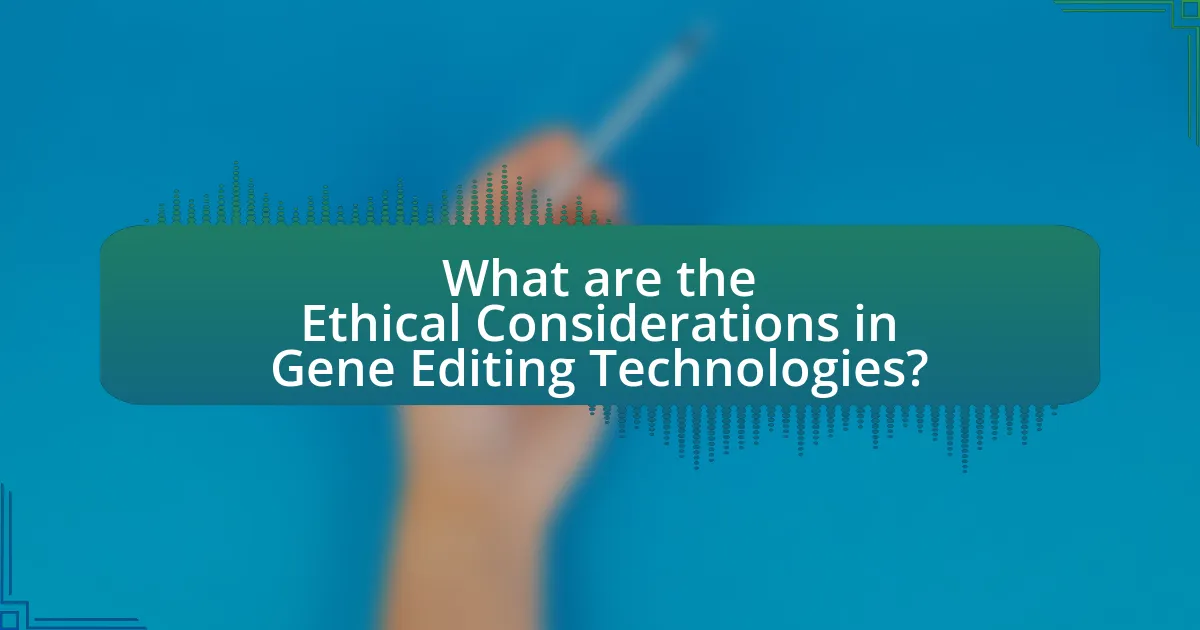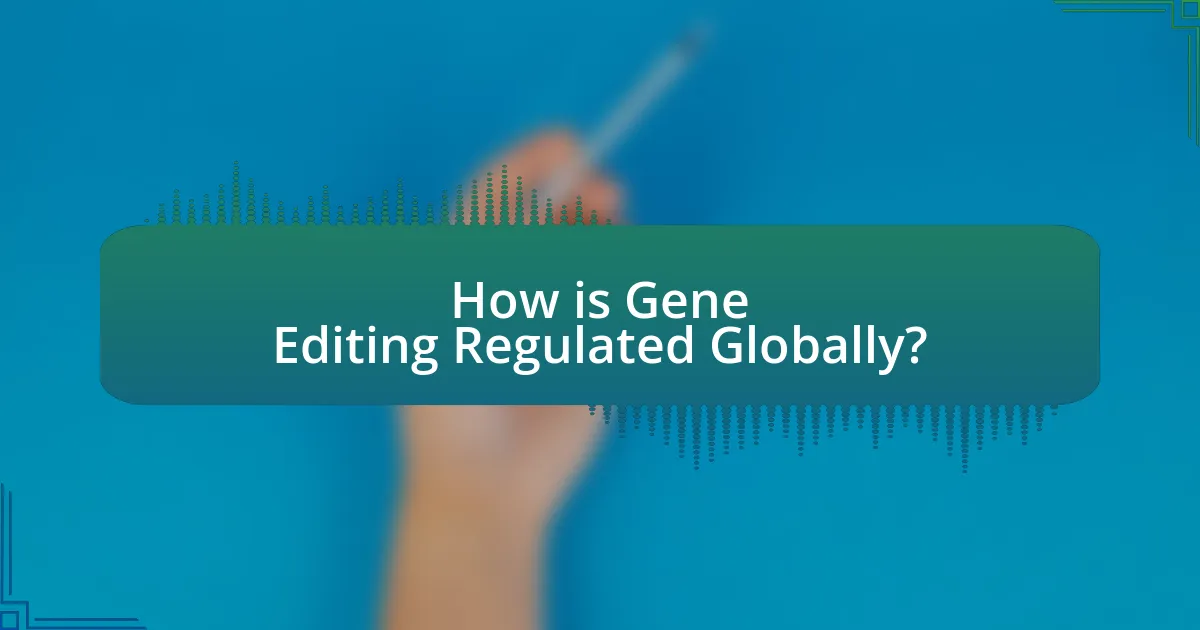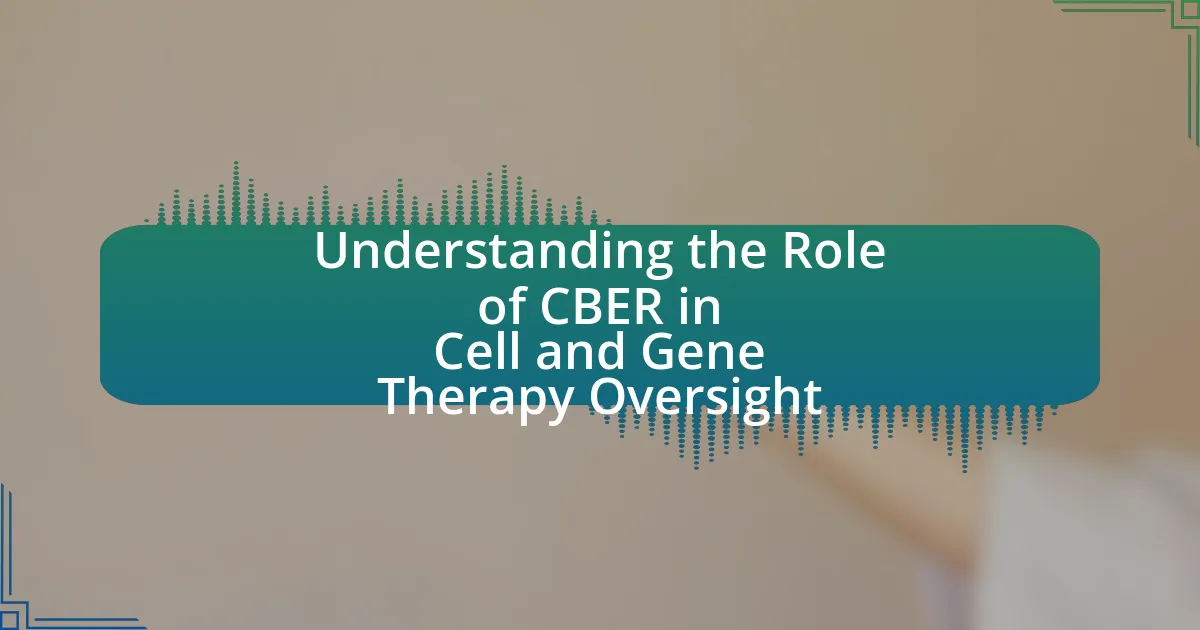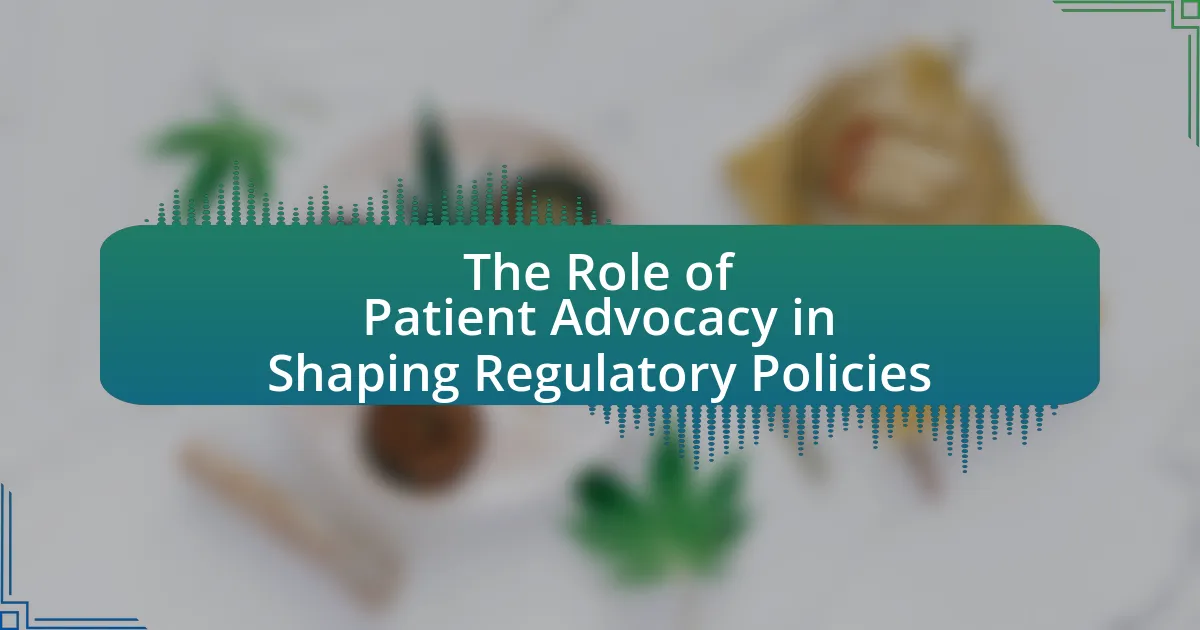The article focuses on the ethical considerations in the regulation of gene editing technologies, highlighting key issues such as safety, consent, equity, and unintended consequences. It examines the importance of ethics in regulating gene editing, discussing various ethical frameworks like utilitarianism and deontological ethics. The article also explores how cultural perspectives influence ethical considerations, the potential risks associated with gene editing, and the implications for biodiversity and ecosystems. Furthermore, it addresses the role of public perception, misinformation, and the need for transparency in research, while outlining global regulatory frameworks and the influence of stakeholders on policy decisions. Finally, it emphasizes the necessity for adaptive regulatory mechanisms and best practices to ensure responsible governance of gene editing technologies.

What are the Ethical Considerations in Gene Editing Technologies?
Ethical considerations in gene editing technologies include concerns about safety, consent, equity, and the potential for unintended consequences. Safety issues arise from the risk of off-target effects, which can lead to harmful genetic alterations, as evidenced by studies showing that CRISPR can inadvertently modify unintended parts of the genome. Consent is crucial, particularly when editing germline cells that affect future generations, raising questions about the rights of individuals who cannot consent. Equity concerns highlight the risk of exacerbating social inequalities, as access to gene editing technologies may be limited to wealthier populations, potentially leading to a genetic divide. Additionally, the potential for “designer babies” raises moral questions about the extent to which humans should intervene in natural processes, as discussed in various bioethical debates. These considerations underscore the need for robust regulatory frameworks to ensure responsible use of gene editing technologies.
Why is ethics important in the regulation of gene editing?
Ethics is crucial in the regulation of gene editing because it ensures that the technology is used responsibly and with consideration for potential societal impacts. The application of gene editing raises significant moral questions regarding human rights, consent, and the potential for unintended consequences, such as genetic discrimination or ecological disruption. For instance, the 2015 case of the CRISPR-edited embryos in China highlighted ethical concerns about the implications of altering human DNA without comprehensive ethical guidelines. Ethical frameworks help to establish boundaries that protect individuals and communities from harm while promoting equitable access to advancements in genetic technology.
What ethical frameworks are commonly applied to gene editing?
Common ethical frameworks applied to gene editing include utilitarianism, deontological ethics, and virtue ethics. Utilitarianism evaluates gene editing based on the outcomes it produces, aiming for the greatest good for the greatest number, as seen in discussions about gene therapies that could alleviate suffering. Deontological ethics focuses on the morality of actions themselves, emphasizing duties and rights, which raises concerns about consent and the potential for genetic discrimination. Virtue ethics considers the character and intentions of those involved in gene editing, promoting responsible stewardship of biotechnological advancements. These frameworks guide ethical decision-making in the complex landscape of gene editing technologies.
How do cultural perspectives influence ethical considerations?
Cultural perspectives significantly influence ethical considerations by shaping the values, beliefs, and norms that dictate what is deemed acceptable or unacceptable behavior within a society. For instance, in cultures that prioritize collectivism, ethical considerations may emphasize community welfare and social harmony over individual rights, leading to different regulatory approaches to gene editing technologies. Conversely, in individualistic cultures, ethical frameworks may focus on personal autonomy and the rights of individuals to make decisions about their genetic makeup. This divergence is evident in global discussions on gene editing, where countries like China and the United States adopt varying regulatory stances based on their cultural values. Research by the National Academy of Sciences highlights that cultural context plays a crucial role in shaping public perceptions and ethical frameworks surrounding biotechnological advancements, underscoring the necessity for culturally sensitive approaches in policy-making.
What are the potential risks associated with gene editing?
The potential risks associated with gene editing include unintended genetic mutations, ecological impacts, and ethical concerns regarding consent and equity. Unintended genetic mutations can occur when gene editing tools, such as CRISPR, inadvertently alter other parts of the genome, leading to unforeseen health issues or genetic disorders. A study published in Nature Biotechnology highlighted that off-target effects can result in significant changes to the genome, which may pose health risks. Ecological impacts arise when gene editing is applied to organisms in the wild, potentially disrupting ecosystems and biodiversity. Additionally, ethical concerns include the implications of gene editing on human subjects, particularly regarding informed consent and the potential for exacerbating social inequalities, as access to these technologies may be limited to certain populations.
How can unintended consequences impact human health?
Unintended consequences can significantly impact human health by leading to unforeseen adverse effects from gene editing technologies. For instance, the CRISPR-Cas9 gene-editing tool, while designed to target specific genes, has been shown to cause off-target mutations that may result in harmful health outcomes, such as increased cancer risk or unintended genetic disorders. A study published in Nature Biotechnology by Tsai et al. (2015) demonstrated that CRISPR could inadvertently modify unintended genomic sites, highlighting the potential for serious health implications. These unintended alterations can disrupt normal biological functions, leading to complications that may not be immediately apparent, thus posing ethical dilemmas in the regulation of such technologies.
What are the implications for biodiversity and ecosystems?
The implications for biodiversity and ecosystems due to gene editing technologies include potential alterations in species interactions and ecosystem dynamics. Gene editing can lead to the introduction of genetically modified organisms that may outcompete native species, disrupt food webs, and alter habitat structures. For instance, the release of gene-edited crops can affect pollinator populations and soil microorganisms, which are crucial for ecosystem health. Studies have shown that invasive species, often enhanced by genetic modifications, can lead to significant declines in native biodiversity, as seen in the case of genetically modified crops in agricultural landscapes. Therefore, careful regulation and assessment of gene editing technologies are essential to mitigate risks to biodiversity and maintain ecosystem integrity.
What role do public perceptions play in gene editing ethics?
Public perceptions significantly influence gene editing ethics by shaping societal norms and regulatory frameworks. When the public expresses concerns or support regarding gene editing technologies, these sentiments can lead to changes in policy and ethical guidelines. For instance, surveys indicate that a majority of people are apprehensive about the implications of gene editing on human embryos, which has prompted regulatory bodies to impose stricter guidelines on such practices. Additionally, public opinion can drive funding and research priorities, as seen in the increased investment in gene editing technologies that align with societal values, such as disease prevention and agricultural sustainability. Thus, public perceptions serve as a critical factor in determining the ethical landscape surrounding gene editing.
How does misinformation affect public opinion on gene editing?
Misinformation significantly skews public opinion on gene editing by fostering fear and misunderstanding about its implications. For instance, studies indicate that exaggerated claims about the risks of gene editing, such as potential health hazards or ethical dilemmas, can lead to increased public resistance to these technologies. A survey conducted by the Pew Research Center found that 49% of Americans expressed concern about gene editing, largely influenced by sensationalized media reports and misinformation campaigns. This distortion of facts can hinder informed discussions and policy-making regarding gene editing, ultimately affecting its acceptance and regulation in society.
What strategies can be used to improve public understanding?
To improve public understanding of ethical considerations in the regulation of gene editing technologies, strategies such as public engagement initiatives, educational programs, and transparent communication should be employed. Public engagement initiatives, like community forums and workshops, allow individuals to voice concerns and ask questions, fostering a two-way dialogue. Educational programs in schools and universities can provide foundational knowledge about gene editing, its implications, and ethical dilemmas. Transparent communication from regulatory bodies and scientists, including clear explanations of research findings and regulatory decisions, can demystify the technology and its ethical considerations. Research indicates that informed public discourse leads to better acceptance and understanding of complex scientific issues, as seen in studies conducted by the Pew Research Center, which highlight the importance of public involvement in science policy discussions.

How is Gene Editing Regulated Globally?
Gene editing is regulated globally through a combination of national laws, international agreements, and ethical guidelines. Various countries have established their own regulatory frameworks, often influenced by international treaties such as the Convention on Biological Diversity and the UNESCO Universal Declaration on Bioethics and Human Rights. For instance, the European Union has stringent regulations regarding gene editing, particularly concerning genetically modified organisms (GMOs), while countries like the United States have a more flexible approach, relying on existing regulatory bodies like the FDA and USDA to oversee gene editing technologies. Additionally, ethical considerations play a crucial role in shaping these regulations, as many nations assess the potential societal impacts and moral implications of gene editing, particularly in human germline editing.
What are the key regulatory frameworks governing gene editing?
The key regulatory frameworks governing gene editing include the U.S. National Institutes of Health (NIH) Guidelines, the European Union’s General Data Protection Regulation (GDPR), and the Convention on Biological Diversity (CBD). The NIH Guidelines provide oversight for research involving recombinant DNA, ensuring safety and ethical standards. The GDPR addresses the handling of personal data in genetic research, emphasizing consent and privacy. The CBD, adopted in 1992, establishes principles for the sustainable use of genetic resources and promotes ethical considerations in biotechnological applications. These frameworks collectively aim to balance innovation in gene editing with ethical responsibilities and public safety.
How do international agreements shape national regulations?
International agreements shape national regulations by establishing common standards and frameworks that countries adopt to ensure compliance with global norms. For instance, treaties like the Convention on Biological Diversity influence national policies on gene editing by promoting biodiversity conservation and sustainable use of genetic resources. This alignment often leads nations to modify their laws to meet international obligations, ensuring that domestic regulations reflect the ethical considerations outlined in these agreements. Such adaptations are crucial for maintaining international cooperation and addressing ethical concerns related to gene editing technologies.
What role do governmental bodies play in regulation?
Governmental bodies play a crucial role in the regulation of gene editing technologies by establishing legal frameworks and guidelines that ensure ethical practices and public safety. These bodies, such as the Food and Drug Administration (FDA) in the United States and the European Medicines Agency (EMA) in Europe, are responsible for assessing the safety and efficacy of gene editing applications before they can be used in clinical settings. For instance, the FDA has implemented regulations that require pre-market approval for gene therapies, ensuring that any new treatments undergo rigorous testing for safety and effectiveness. Additionally, governmental bodies often engage in public consultations and stakeholder discussions to address ethical concerns, such as potential long-term impacts on human genetics and biodiversity. This regulatory oversight is essential to balance innovation in gene editing with the protection of public health and ethical standards.
What are the differences in regulation across countries?
Regulation of gene editing technologies varies significantly across countries, primarily due to differing ethical standards, cultural values, and legal frameworks. For instance, the United States allows for more extensive research and application of gene editing technologies, such as CRISPR, under the oversight of the Food and Drug Administration (FDA), which emphasizes innovation and market-driven solutions. In contrast, countries like Germany and France impose stricter regulations, reflecting a cautious approach that prioritizes ethical considerations and public safety, often prohibiting germline editing altogether. Additionally, the United Kingdom has established a regulatory framework that permits certain gene editing practices under strict conditions, balancing innovation with ethical oversight. These differences highlight how national policies are shaped by unique societal values and historical contexts, influencing the pace and direction of gene editing advancements globally.
How do ethical considerations vary in different legal systems?
Ethical considerations vary significantly across different legal systems, primarily influenced by cultural, religious, and philosophical beliefs. For instance, in the United States, the legal framework surrounding gene editing emphasizes individual rights and innovation, often prioritizing scientific advancement over ethical constraints. Conversely, European legal systems, particularly in countries like Germany and France, adopt a more precautionary approach, emphasizing the protection of human dignity and the potential long-term societal impacts of gene editing. This divergence is evident in regulations such as the European Union’s strict guidelines on genetic modification, which reflect a collective ethical stance prioritizing public health and environmental safety. These differences illustrate how legal systems shape ethical frameworks, impacting the regulation of emerging technologies like gene editing.
What examples illustrate contrasting regulatory approaches?
The contrasting regulatory approaches in gene editing technologies can be illustrated by the United States and the European Union. In the United States, the regulatory framework is more permissive, allowing for rapid development and commercialization of gene editing technologies, as evidenced by the FDA’s approval of gene therapies like Luxturna for inherited retinal disease in 2017. Conversely, the European Union adopts a more precautionary approach, emphasizing extensive safety assessments and ethical considerations, as seen in the strict regulations under the EU’s Genetically Modified Organisms (GMO) Directive, which requires rigorous testing and public consultation before approval. This divergence highlights the balance between innovation and ethical oversight in different regulatory environments.
How do stakeholders influence gene editing regulations?
Stakeholders influence gene editing regulations by advocating for their interests, shaping public perception, and providing expertise. For instance, biotechnology companies lobby for favorable regulations that facilitate innovation and commercialization, while environmental and ethical advocacy groups push for stricter oversight to address potential risks and moral concerns. Academic institutions contribute research and data that inform regulatory frameworks, ensuring that policies are based on scientific evidence. The interplay of these influences is evident in the development of guidelines by organizations such as the National Institutes of Health and the World Health Organization, which incorporate stakeholder input to balance innovation with safety and ethical considerations.
What is the role of scientists and researchers in shaping policy?
Scientists and researchers play a crucial role in shaping policy by providing evidence-based insights that inform decision-making processes. Their expertise in areas such as genetics, ethics, and technology enables them to assess the implications of gene editing technologies, guiding policymakers in creating regulations that balance innovation with ethical considerations. For instance, the National Academy of Sciences has emphasized the importance of scientific input in developing guidelines for gene editing, highlighting that informed policies can mitigate risks while promoting beneficial applications. This integration of scientific knowledge into policy frameworks ensures that regulations are grounded in current research and ethical standards, ultimately fostering responsible advancements in gene editing.
How do advocacy groups impact regulatory decisions?
Advocacy groups significantly influence regulatory decisions by mobilizing public opinion, providing expert testimony, and lobbying policymakers. These organizations often represent specific interests or ethical concerns, such as those related to gene editing technologies, and they can sway regulatory outcomes by highlighting potential risks or benefits. For instance, advocacy groups like the Center for Genetics and Society have actively campaigned for regulations that prioritize ethical considerations in gene editing, emphasizing the need for oversight to prevent misuse. Their efforts can lead to increased scrutiny from regulatory bodies, resulting in more stringent guidelines or policies that reflect public concerns and ethical standards.

What are the Future Directions for Ethical Regulation of Gene Editing?
Future directions for ethical regulation of gene editing include the establishment of comprehensive international frameworks, increased public engagement, and the development of adaptive regulatory mechanisms. Comprehensive international frameworks are essential to address the global nature of gene editing technologies, as seen in initiatives like the UNESCO Universal Declaration on Bioethics and Human Rights. Increased public engagement is crucial for understanding societal values and concerns, which can be informed by public consultations and participatory governance models. Adaptive regulatory mechanisms are necessary to keep pace with rapid advancements in gene editing, as demonstrated by the evolving guidelines from organizations such as the National Institutes of Health and the World Health Organization, which emphasize the need for flexible regulations that can respond to new scientific developments and ethical challenges.
How can ethical guidelines evolve with technological advancements?
Ethical guidelines can evolve with technological advancements by incorporating ongoing research, stakeholder input, and adaptive regulatory frameworks. As gene editing technologies progress, ethical considerations must be continuously reassessed to address emerging challenges, such as unintended genetic consequences and equitable access. For instance, the rapid development of CRISPR technology has prompted organizations like the National Academy of Sciences to recommend iterative reviews of ethical standards, ensuring they remain relevant and effective in safeguarding public interest. This approach allows for the integration of new scientific insights and societal values, fostering a dynamic ethical landscape that aligns with technological capabilities.
What role does continuous dialogue play in ethical evolution?
Continuous dialogue is essential for ethical evolution as it fosters an ongoing exchange of ideas, perspectives, and values among stakeholders. This interaction allows for the identification and reassessment of ethical principles in response to new developments, such as advancements in gene editing technologies. For instance, the rapid progress in CRISPR technology has prompted discussions among scientists, ethicists, policymakers, and the public, leading to evolving guidelines that reflect societal values and ethical considerations. Research by the National Academy of Sciences emphasizes that inclusive dialogue can enhance public trust and ensure that ethical frameworks remain relevant and adaptable to emerging challenges in biotechnology.
How can adaptive regulatory frameworks be developed?
Adaptive regulatory frameworks can be developed by incorporating iterative processes that allow for continuous learning and adjustment based on emerging scientific evidence and societal values. This approach involves stakeholder engagement, where policymakers collaborate with scientists, ethicists, and the public to identify ethical concerns and regulatory needs specific to gene editing technologies. For instance, the National Academy of Sciences emphasizes the importance of adaptive governance in its report on gene editing, advocating for frameworks that can evolve alongside technological advancements and public sentiment. By utilizing real-time data and feedback mechanisms, regulatory bodies can ensure that regulations remain relevant and effective in addressing ethical considerations.
What best practices can be implemented for ethical gene editing?
Best practices for ethical gene editing include establishing clear regulatory frameworks, ensuring informed consent, promoting transparency in research, and engaging diverse stakeholders in decision-making processes. Regulatory frameworks, such as those proposed by the National Academies of Sciences, Engineering, and Medicine, provide guidelines that balance innovation with safety and ethical considerations. Informed consent ensures that individuals understand the implications of gene editing, as highlighted in the 2017 report by the International Summit on Human Gene Editing. Transparency in research fosters public trust and accountability, while stakeholder engagement, including input from ethicists, scientists, and the public, helps address societal concerns and ethical dilemmas associated with gene editing technologies.
How can transparency be ensured in gene editing research?
Transparency in gene editing research can be ensured through rigorous peer review, public disclosure of research methodologies, and adherence to ethical guidelines. Peer review processes, such as those implemented by journals like Nature and Science, require researchers to submit their findings for evaluation by other experts, which promotes accountability and scrutiny. Public disclosure involves making research protocols and data accessible to the public, as seen in initiatives like the Open Science Framework, which encourages sharing of research practices and results. Furthermore, adherence to ethical guidelines established by organizations such as the National Institutes of Health ensures that researchers follow best practices in reporting and conducting gene editing studies, thereby fostering trust and transparency in the field.
What measures can promote public engagement in ethical discussions?
To promote public engagement in ethical discussions, implementing inclusive forums and educational initiatives is essential. These measures facilitate dialogue among diverse stakeholders, including scientists, ethicists, policymakers, and the general public. Research indicates that structured public deliberation, such as citizen panels or town hall meetings, enhances understanding and allows for a variety of perspectives to be shared, fostering a more informed community. For instance, the National Academy of Sciences has highlighted that engaging the public through workshops and discussions can significantly improve awareness and understanding of complex issues like gene editing technologies.
What are the implications of emerging technologies on gene editing ethics?
Emerging technologies significantly impact gene editing ethics by introducing complex dilemmas regarding consent, equity, and unintended consequences. The rapid advancement of tools like CRISPR raises questions about the moral implications of altering human genomes, particularly concerning the potential for designer babies and the exacerbation of social inequalities. For instance, a study published in Nature Biotechnology highlights that unequal access to gene editing technologies could lead to a genetic divide, where only affluent individuals benefit from enhancements, thereby deepening existing societal disparities. Furthermore, the potential for off-target effects in gene editing raises ethical concerns about the long-term health implications for individuals and future generations, as evidenced by research from the Broad Institute, which emphasizes the need for rigorous safety assessments. These factors necessitate a reevaluation of ethical frameworks to ensure responsible governance of gene editing technologies.
How might artificial intelligence influence ethical decision-making?
Artificial intelligence can significantly influence ethical decision-making by providing data-driven insights that enhance the understanding of complex ethical dilemmas. AI systems can analyze vast amounts of information, identify patterns, and predict outcomes, which can help decision-makers evaluate the potential consequences of their choices more effectively. For instance, in the context of gene editing technologies, AI can assess the long-term impacts of genetic modifications on health and the environment, thereby informing ethical considerations. Research has shown that AI can improve the accuracy of risk assessments, as demonstrated in studies like “AI in Healthcare: Anticipating the Future” by Obermeyer et al., which highlights AI’s role in enhancing decision-making processes in medical ethics.
What challenges do new technologies pose for existing regulations?
New technologies, particularly in gene editing, challenge existing regulations by outpacing the legal frameworks designed to govern them. The rapid advancement of techniques like CRISPR has created scenarios where current laws may not adequately address ethical concerns, safety protocols, and potential misuse. For instance, the lack of specific regulations regarding germline editing raises questions about consent, long-term effects, and societal implications, which existing regulations do not fully encompass. This gap can lead to inconsistent enforcement and a regulatory environment that struggles to keep pace with innovation, ultimately risking public safety and ethical standards.




